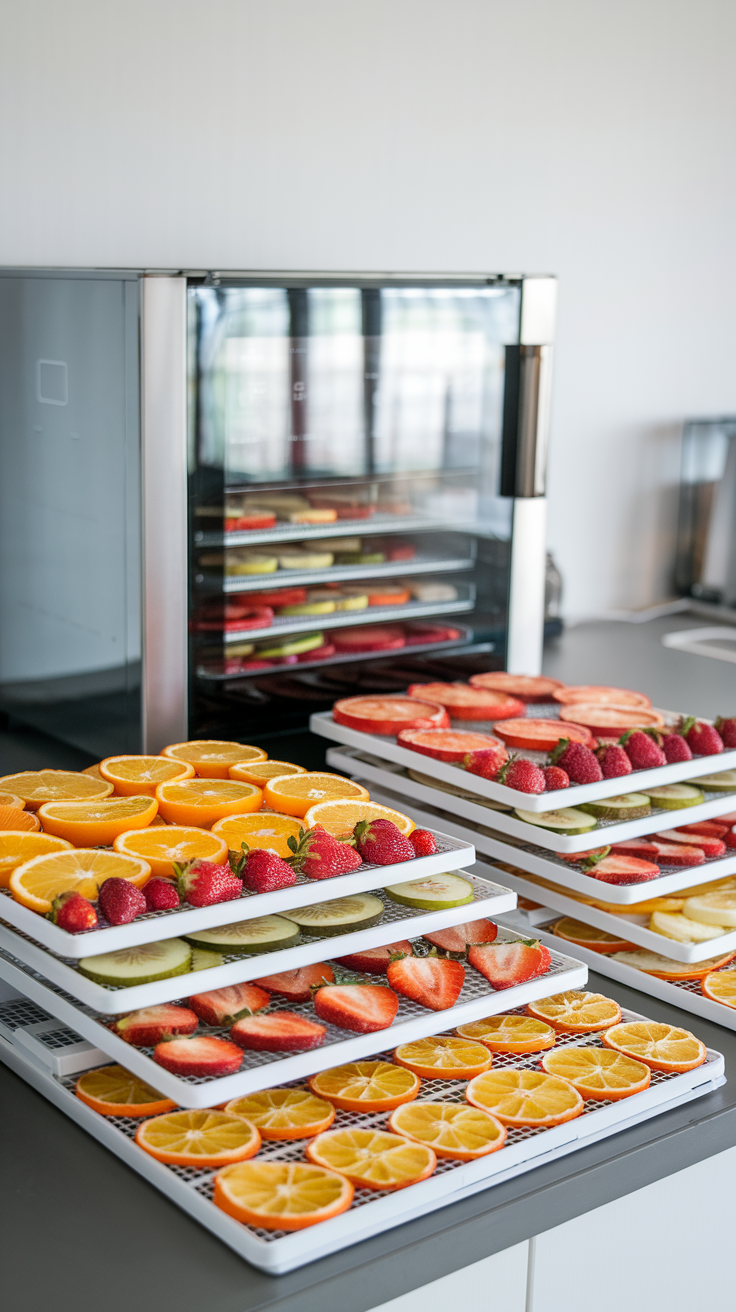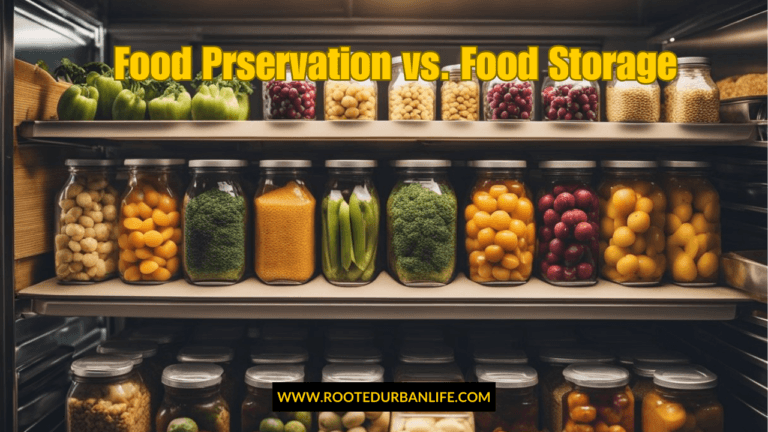The Complete Beginner’s Guide to Choosing the Best Food Dehydrator
Choosing a dehydrator can be a fun and rewarding process, especially if you’re interested in making your own snacks. The best dehydrator for beginners is one that is easy to use, has adjustable temperature settings, and offers good airflow to ensure even drying. With many options available, it’s important to know what features matter most for your needs.
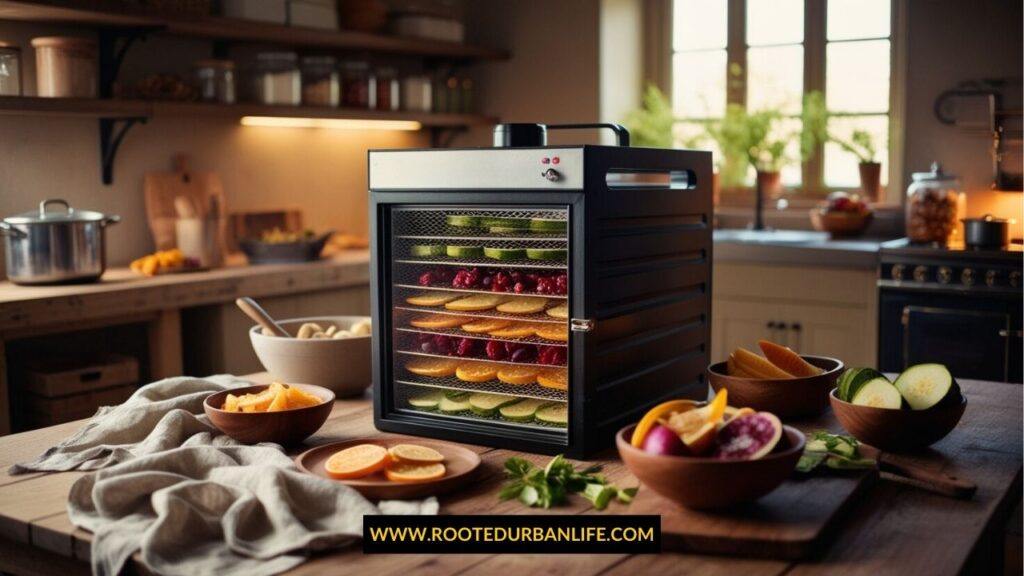
You might be wondering what to consider when picking a dehydrator. Look for one with a clear design so you can monitor your food easily. Also, think about the size and capacity. Depending on how much you plan to dehydrate, a larger model may serve you better.
Getting started with dehydrating can open up a world of possibilities. From fruits and vegetables to jerky and yogurt, you can preserve food in a healthy and delicious way. Let’s explore how you can find the right dehydrator that fits your lifestyle and kitchen needs.
In this guide, we’ll help you choose the best dehydrator for beginners by exploring key factors like design, temperature control, and capacity. You’ll learn about different types of dehydrators, essential features to look for, safety tips, and maintenance advice. We’ll also walk you through the basics of dehydrating various foods, from fruits and jerky to herbs. Plus, you’ll find expert tips for ensuring consistent results and troubleshooting common challenges. Whether you’re just starting or upgrading your dehydrating setup, this article will equip you with the knowledge you need to make an informed choice.
Understanding Food Dehydrators
Food dehydrators help you remove moisture from fruits, vegetables, and meats, making it easier to store and preserve food. You’ll find different types of dehydrators, features to think about, and important safety tips to follow.
Types of Dehydrators: Pros and Cons
There are mainly two types of food dehydrators: horizontal airflow and vertical airflow.
Horizontal Airflow Dehydrators:
- Pros: Heat is evenly distributed. This helps prevent uneven drying. Great for larger batches.
- Cons: Usually more expensive and can take up more counter space.
Vertical Airflow Dehydrators:
- Pros: Typically less expensive and more compact, making them good for smaller kitchens. Easy to store and move.
- Cons: Air doesn’t circulate as well, so you may need to rotate trays for even drying.
Choosing the right type depends on your budget, space, and how often you plan to use it.
Key Features to Consider
When selecting a dehydrator, pay attention to the following features:
- Temperature Control: Adjustable settings let you select the right temperature for different foods, improving drying efficiency.
- Timer: A built-in timer helps prevent over-drying, giving you more control.
- Tray Material: Look for BPA-free materials. Sturdy trays are important for long-lasting use.
- Capacity: Consider how much food you want to dry at one time. Larger models are better for big families.
- Noise Level: Some dehydrators can be noisy, so think about where you will use it.
These features will improve your drying experience.
Food Safety and Dehydration
Food safety is crucial when using a dehydrator.
- Start Fresh: Always use fresh, high-quality ingredients. This keeps your dried food safe and tasty.
- Pre-Treat Certain Foods: For items like apples or peaches, consider using lemon juice or another acid to prevent browning and help with preservation.
- Proper Drying: Ensure food is dried thoroughly. Moisture can lead to mold growth, which is unsafe to eat.
- Storage: Use airtight containers for storing dried food. Store them in a cool, dark place to maintain quality.
Following these safety tips will ensure your dried foods are safe and delicious.
Selecting the Best Dehydrator for Beginners
Choosing the right dehydrator can make a big difference in your drying experience. Understanding your needs and budget is essential. Here are some key points to help you make an informed choice.
Assessing Your Needs
Start by thinking about what you plan to dehydrate. If you want to dry fruits, vegetables, or meats, your choice will differ.
Size and Capacity: Think about how much food you want to dry at once. If you have a big family or plan to preserve large batches, look for a model with more trays. Dehydrators like the Excalibur have a larger capacity, making them suitable for heavy users.
Performance: Check the temperature range and drying speed. Some dehydrators allow for precise temperature control, which is crucial for drying meats safely.
Top Picks for Starters
Here are three great dehydrators for beginners:
Nesco Snackmaster: This model is affordable and easy to use. It’s compact, with a stackable design, making it a good choice for small kitchens. It has a good temperature range for fruits and vegetables.
Magic Mill: This dehydrator offers more capacity and features. It has a digital display and adjustable thermostat, perfect for precise drying. It’s ideal if you plan to dehydrate larger batches.
Tribest Sedona Express: This one is for those who want advanced features. It has a dual fan system and independent tray control. It allows for different foods to dry at different temperatures.
Budgeting for Quality and Performance
Dehydrators come in various price ranges. Consider how often you will use the dehydrator.
Under $100: Models like the Nesco are good for beginners. They provide decent performance without breaking the bank.
$100–$300: Dehydrators like the Magic Mill offer better capacity and features. They are more durable and suitable for frequent use.
Above $300: The Excalibur or Tribest Sedona Express are for serious enthusiasts. They provide the best features and performance, especially if you plan to dehydrate regularly.
Investing a little more can lead to better results and satisfaction.
Using Your Dehydrator Effectively
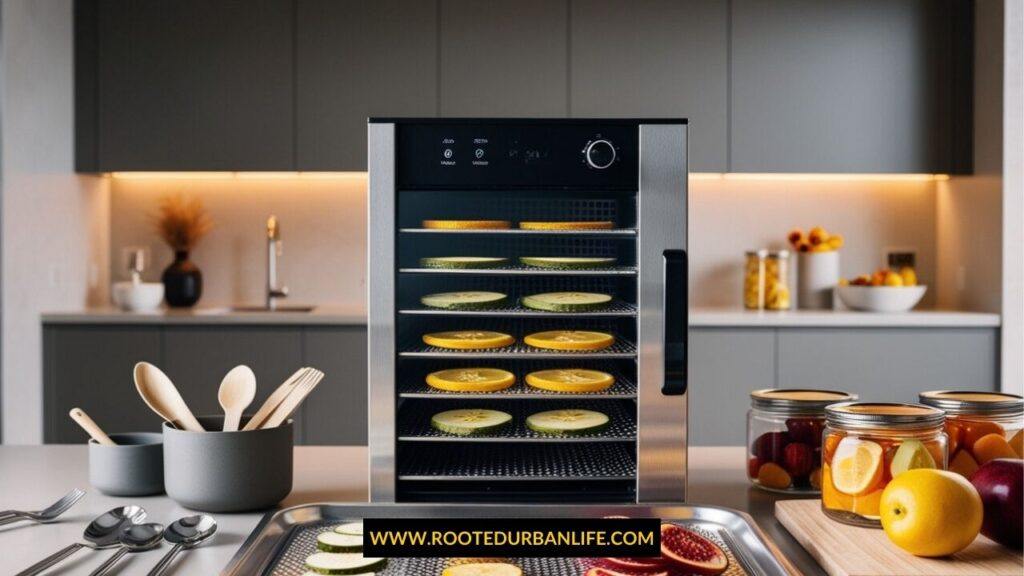
To get the best results from your food dehydrator, it’s important to prepare your items correctly, control the temperature, and utilize the drying space efficiently. This will help you make delicious snacks like beef jerky or fruit leather and preserve herbs and other foods.
Preparing Foods for Dehydration
Before you start dehydrating, prep your foods properly. Wash fruits and vegetables to remove dirt. Cut them into uniform sizes to ensure even drying. For tougher items like beef for jerky, slice against the grain for the best texture.
Certain fruits, such as apples or pears, benefit from soaking in an acid solution made of water and lemon juice. This helps prevent browning and keeps them looking fresh.
Tip: Keep herbs whole or chop them for faster drying.
Make sure to remove any seeds, pits, or blemishes from your foods. This ensures better flavor and texture in the final product.
Mastering Temperature Control
Temperature is crucial for effective dehydration. Most foods dry best between 125°F to 135°F (52°C to 57°C). Use your dehydrator’s settings to adjust temperatures based on what you’re drying.
For meats like beef jerky, higher temperatures (around 160°F or 71°C) are necessary to ensure safety. Always refer to your dehydrator’s manual for specific guidance on temperature settings.
Remember: Different foods have different drying times. Keep an eye on them and check for the desired dryness.
You can start with lower temperatures for fruits and then raise them for herbs to retain more flavor.
Maximizing Even Drying and Space
To ensure even drying, arrange your food in a single layer without stacking. If using racks, avoid overlapping pieces. This allows air to flow freely and prevents sogginess.
Use trays wisely: If your dehydrator has multiple trays, place foods that require similar drying times on the same level.
Certain items like thicker veggies might need extra space. It’s better to give them room to dry properly than to rush the process.
Check for dry spots and rearrange items as needed during the process. This helps achieve a uniform texture in your dried goods.
Maintenance and Cleaning
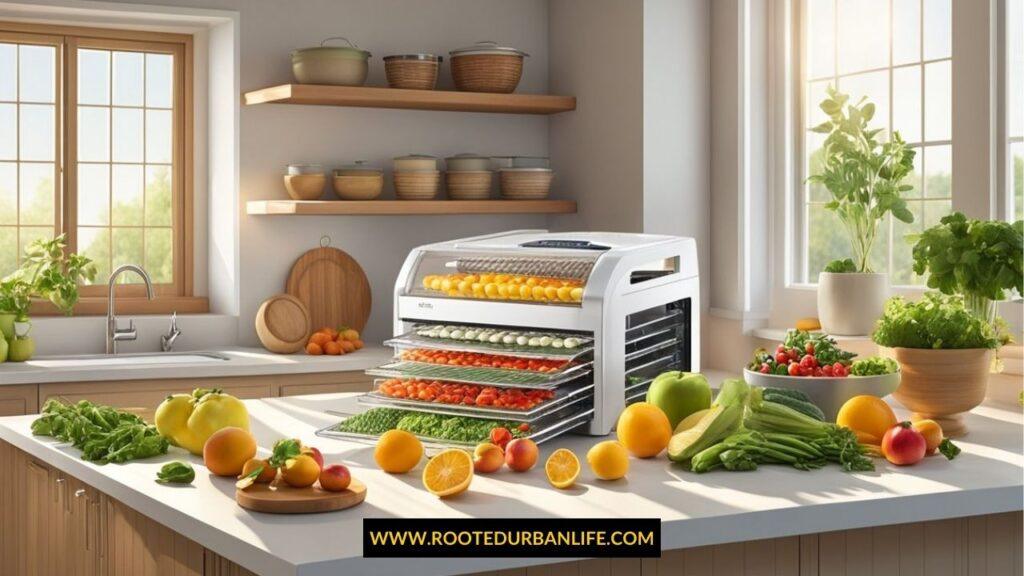
Caring for your dehydrator helps it last longer and work better. Regular cleaning keeps it safe and ensures your food stays tasty.
Regular Care for Longevity
To keep your dehydrator in good shape, perform regular checks. Make sure to inspect the trays and the body for debris or food particles after each use. BPA-free trays are a great option as they are safer and easier to clean. If your model comes with dishwasher-safe trays, wash them in the dishwasher for convenience. Always let the trays dry completely before storing them to prevent mold growth.
Keep the dehydrator in a clean and dry place, away from moisture. Use a damp cloth to wipe down the exterior and ensure the air vents are clear. Checking the power cord for any damage is also important.
Cleaning Best Practices
Cleaning your dehydrator is key to maintaining food safety. Start by unplugging the unit and allowing it to cool. Remove the trays and soak them in warm, soapy water. For tougher stains, use a non-abrasive sponge or cloth.
Avoid cleaning products with strong scents or chemicals that may linger. Rinse the trays thoroughly and dry them before placing them back.
The dehydrator’s interior can be wiped with a damp cloth or sponge. If there are any stubborn spots, a mixture of vinegar and water can help. Always refer to the manufacturer’s guidelines for specific cleaning recommendations. Following these practices ensures your dehydrator remains in excellent condition.
Advanced Dehydrating Techniques
Once you get comfortable with basic dehydrating, you can explore advanced techniques to expand your options. You can create a wide range of foods and achieve better consistency with some tips and tricks.
Creating a Variety of Dehydrated Foods
To maximize your dehydrating experience, try different foods. You can dehydrate fruits like apple rings for a sweet snack or make dried jerky from beef, turkey, or other meats. Choose lean cuts for the best texture.
For vegetables, you can dry peppers, carrots, and zucchini. These can be used in soups or snacking. Don’t forget to dry herbs, such as basil and oregano. Dehydrating enhances their flavor and preserves them for later use.
A digital food dehydrator like the Excalibur 9-Tray Electric Food Dehydrator allows you to manage drying times and temperatures easily. Layer foods on the trays without overlapping for even drying.
Expert Tips for Consistent Results
For the best results, cut your food into uniform sizes. This helps ensure even drying. Use a mandoline for fruits and vegetables to achieve uniform thickness.
Keep your dehydrator clean. Regular maintenance prevents cross-contamination of flavors. Always store your dried foods in airtight containers to keep them fresh.
Pay attention to the drying times specific to each food. Fruits generally take 6-12 hours, while meat may take much longer, sometimes up to 24 hours for jerky. Check frequently using a food thermometer to ensure proper temperatures for safety.
Frequently Asked Questions
Choosing the right food dehydrator can be confusing. Here are some common questions that many beginners have when selecting a dehydrator.
What are the essential features to look for in a food dehydrator for beginners?
When picking a food dehydrator, you should look for adjustable temperature settings, good airflow, and a timer. These features help you control the drying process better. A model with a removable tray can also make cleaning easier.
How can one decide between a square and round food dehydrator?
Square dehydrators usually have more space and can hold more trays. They also stack better for storage. Round dehydrators may take up less room, but their design might limit tray space.
What should a first-time buyer consider when selecting a food dehydrator?
Think about your budget, how much food you want to dry, and the types of food you will be dehydrating. Check reviews to see how easy the dehydrator is to use and clean.
Which food dehydrator is recommended by consumer reports for novices?
Consumer Reports often suggests brands like Excalibur and Nesco for beginners. These brands are known for their reliability and ease of use. They offer good customer support, which can be helpful for first-time users.
Are there any affordable yet reliable food dehydrators suitable for beginners?
Yes, models from brands like Presto and Hamilton Beach are affordable and reliable. They often provide useful features without the high price tag. This makes them great options for beginners starting their dehydrating journey.
What are the top-rated food dehydrators for beginners available on major retail websites?
Popular options include the Excalibur 3926TB and the Nesco FD-75A. Both have good reviews and offer essential features for beginners. You can find them on major retail websites, which often include customer ratings and detailed descriptions.
Key Takeaways
Choose the Right Type: Decide between horizontal or vertical airflow dehydrators based on your space, budget, and how often you plan to use the dehydrator. Focus on Key Features: Look for adjustable temperature control, a timer, BPA-free trays, and a capacity that suits your needs. These features ensure better drying results and convenience. Food Safety is Essential: Always use fresh, high-quality ingredients, and follow proper food preparation and drying techniques to prevent spoilage and ensure safe storage. Regular Maintenance Matters: Clean your dehydrator after each use, and check for any wear and tear to keep it running smoothly for years. Start Small, Then Expand: Beginners can start with budget-friendly models and experiment with different foods. As you gain experience, consider upgrading to larger models with more advanced features.
Choosing the right food dehydrator is an exciting step toward preserving your favorite foods in a healthy and delicious way. With the right model and some basic knowledge, you’ll be ready to dehydrate everything from fruits to jerky and beyond. Now that you have a better understanding of the types, features, and best practices, it’s time to start your dehydrating journey.
We’d love to hear about your experiences with food dehydrating. Share your tips, questions, or feedback with us in the comments below. Don’t forget to subscribe to our blog for more helpful guides and tips on food preservation and other kitchen essentials. Happy dehydrating.




